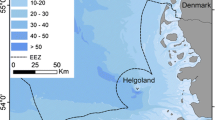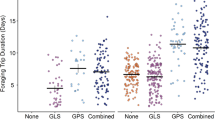Abstract
The Black-legged Kittiwake Rissa tridactyla is the most abundant gull species in the world, but some populations have declined in recent years, apparently due to food shortage. Kittiwakes are surface feeders and thus can compensate for low food availability only by increasing their foraging range and/or devoting more time to foraging. The species is widely studied in many respects, but long-distance foraging and the limitations of conventional radio telemetry have kept its foraging behavior largely out of view. The development of Global Positioning System (GPS) loggers is advancing rapidly. With devices as small as 8 g now available, it is possible to use this technology for tracking relatively small species of oceanic birds like kittiwakes. Here we present the first results of GPS telemetry applied to Black-legged Kittiwakes in 2007 in the North Pacific. All but one individual foraged in the neritic zone north of the island. Three birds performed foraging trips only close to the colony (within 13 km), while six birds had foraging ranges averaging about 40 km. The maximum foraging range was 59 km, and the maximum distance traveled was 165 km. Maximum trip duration was 17 h (mean 8 h). An apparently bimodal distribution of foraging ranges affords new insight on the variable foraging behaviour of Black-legged Kittiwakes. Our successful deployment of GPS loggers on kittiwakes holds much promise for telemetry studies on many other bird species of similar size and provides an incentive for applying this new approach in future studies.




Similar content being viewed by others
References
Ainley DG, Ford RG, Brown ED, Suryan RM, Irons DB (2003) Prey resources, competition, and geographic structure of Kittiwake colonies in Prince William Sound. Ecology 84:709–723
Beamish RJ, Leask KD, Ivanov OA, Balanov AA, Orlov AM, Sinclair B (1999) The ecology, distribution, and abundance of midwater fishes of the Subarctic Pacific gyres. Prog Oceanogr 43:399–442
Caccamise DF, Hedin RS (1985) An aerodynamic basis for selecting transmitter loads in birds. Wilson Bull 97:306–318
Calvo B, Furness RW (1992) A review of the use and the effects of marks and devices on birds. Ring Migr 13:129–151
Camphuysen CJ (2005) Understanding marine foodweb processes: an ecosystem approach to sustainable sandeel fisheries in the North Sea. impress final report. Royal Netherlands Institute for Sea Research, Texel
Congdon BC, Krockenberger AK, Smithers BV (2005) Dual-foraging and co-ordinated provisioning in a tropical procellariiform, the wedge-tailed shearwater. Mar Ecol Prog Ser 301:293–301
Coulson JC, Johnson MP (1993) The attendance and absence of adult Kittiwakes Rissa tridactyla from the nest site during the chick stage. Ibis 135:372–378
Daunt F, Benvenuti S, Harris MP, Dall’Antonia L, Elston DA, Wanless S (2002) Foraging strategies of the black-legged kittiwake Rissa tridactyla at a North Sea colony: evidence for a maximum foraging range. Mar Ecol Prog Ser 245:239–247
Daunt F, Peters G, Scott B, Grémillet D, Wanless S (2003) Rapid-response recorders reveal interplay between marine physics and seabird behaviour. Mar Ecol Prog Ser 255:283–288
Del Hoyo J, Elliott A, Sargatal J (1996) Handbook of the birds of the world, vol 3. Lynx Edictions, Barcelona
Dierschke V, Garthe S, Markones N (2004) Aktionsradien Helgoländer Dreizehenmöwen Rissa tridactyla und Trottellummen Uria aalge während der Aufzuchtphase. Vogelwelt 125:11–19
Frederiksen M, Mavor RA, Wanless S (2007) Seabirds as environmental indicators: the advantages of combining data sets. Mar Ecol Prog Ser 352:205–211
Frederiksen M, Jensen H, Daunt F, Mavor RA, Wanless S (2008) Differential effects of a local industrial sand lance fishery on seabird breeding performance. Ecol Appl 18:701–710
Furness RW, Tasker ML (2000) Seabird-fishery interactions: quantifying the sensitivity of seabirds to reductions in sandeel abundance, and identification of key areas for sensitive seabirds in the North Sea. Mar Ecol Prog Ser 202:253–264
Garthe S, Montevecchi WA, Davoren GK (2007) Flight destinations and foraging behaviour of northern gannets (Sula bassana) preying on a small forage fish in a low-arctic ecosystem. Deep Sea Res Part II 54:311–320
Gill VA, Hatch SA (2002) Components of productivity in Black-legged Kittiwakes Rissa tridactyla: response to supplemental feeding. J Avian Biol 33:113–126
Gill VA, Hatch SA, Lanctot RB (2002) Sensitivity of breeding parameters to food supply in Black-legged Kittiwakes Rissa tridactyla. Ibis 144:268–283
Götmark F (1980) Foraging flights of Kittiwakes-some functional aspects. Vår Fågelvärld 39:65–74
Grémillet D, Storch S, Peters G (2000) Determining food requirements in marine top predators: a comparison of three independent techniques in Great Cormorants, Phalacrocorax carbo carbo. Can J Zool 78:1567–1579
Grémillet D, Omo GD, Ryan PG, Peters G, Ropert-Coudert Y, Weeks SJ (2004) Offshore diplomacy, or how seabirds mitigate intra-specific competition: a case study based on GPS tracking of Cape gannets from neighbouring colonies. Mar Ecol Prog Ser 268:265–279
Hamer KC, Monaghan P, Uttley JD, Walton P, Burns MD (1993) The influence of food supply on the breeding ecology of Kittiwakes Rissa tridactyla in Shetland. Ibis 135:255–263
Hamer KC, Humphreys EM, Garthe S, Hennicke J, Peters G, Grémillet D, Phillips RA, Harris MP, Wanless S (2007) Annual variation in diets, feeding locations and foraging behaviour of gannets in the North Sea: flexibility, consistency and constraint. Mar Ecol Prog Ser 338:295–305
Harding AMA, Piatt JF, Schmutz JA, Shultz MT, Pelt TIV, Kettle AB, Speckman SG (2007) Prey density and the behavioral flexibility of a marine predator: the Common Murre (Uria aalge). Ecology 88:2024–2033
Harris MP, Wanless S (1990) Breeding success of british kittiwakes rissa tridactyla in 1986–1988—evidence for changing conditions in the Northern North Sea. J Appl Ecol 27:172–187
Hatch SA, Roberts BD, Fadely BS (1993a) Adult survival of Black-legged Kittiwakes Rissa tridactyla in a Pacific colony. Ibis 135:247–254
Hatch SA, Byrd GV, Irons DB, Hunt GL Jr (1993b) Status and ecology of kittiwakes (Rissa tridactyla and R. brevirostris) in the North Pacific. Canadian Wildlife Service, Ottawa
Hatch SA, Robertson GJ, Baird PH (2009) Black-legged Kittiwake (Rissa tridactyla). In: Poole A (ed) The birds of North America online. Cornell Lab of Ornithology, Ithaca
Hulbert IAR, French J (2001) The accuracy of GPS for wildlife telemetry and habitat mapping. J Appl Ecol 38:869–878
Humphreys EM, Wanless S, Bryant DM (2006) Stage-dependent foraging in breeding black-legged kittiwakes Rissa tridactyla: distinguishing behavioural responses to intrinsic and extrinsic factors. J Avian Biol 37:436–446
Hünerbein Kv, Hamann HJ, Ruter E, Wiltschko W (2000) A GPS-based system for recording the flight path of birds. Naturwissenschaften 87:278–279
Jodice PGR, Lanctot RB, Gill VA, Roby DD, Hatch SA (2000) Sexing adult black-legged Kittiwakes by DNA, behavior, and morphology. Waterbirds 23:405–415
Kitaysky AS, Hunt GL Jr, Flint EN, Rubega MA, Decker MB (2000) Resource allocation in breeding seabirds: responses to fluctuations in their food supply. Mar Ecol Prog Ser 206:283–296
Monaghan P (1996) Relevance of the behaviour of seabirds to the conservation of marine environments. Oikos 77:227–237
Pearson TH (1968) The feeding biology of sea-bird species breeding on the Farne Islands, Northumberland. J Anim Ecol 37:521–552
Pennycuick CJ (1987) Flight of auks (Alcidae) and other northern seabirds compared with southern precellariiformes: ornithodolite observations. J Exp Biol 128:335–347
Pennycuick CJ (1997) Actual and ‘optimum’ flight speeds: field data reassessed. J Exp Biol 2000:2355–2361
Phillips RA, Xavier JC, Croxall JP (2003) Effects of satellite transmitters on albatrosses and petrels. Auk 120:1082–1090
Roberts BD, Hatch SA (1993) Behavioral ecology of Black-legged Kittiwakes during chick rearing in a failing colony. Condor 95:330–342
Sinclair EH, Stabeno PJ (2002) Mesopelagic nekton and associated physics of the southeastern Bering Sea. Deep Sea Res Part II 49:6127–6145
Suryan RM, Irons DB, Benson J (2000) Prey switching and variable foraging strategies of Black-legged Kittiwakes and the effect on reproductive success. Condor 102:374–384
Suryan RM, Irons DB, Brown ED, Jodice PGR, Roby DD (2006) Site-specific effects on productivity of an upper trophic-level marine predator: bottom-up, top-down, and mismatch effects on reproduction in a colonial seabird. Prog Oceanogr 68:303–328
Van Pelt TI, Piatt JF, Lance BK, Roby DD (1997) Proximate composition and energy density of some North Pacific forage fishes. Comp Biochem Physiol A-Mol Integr Physiol 118:1393–1398
Wanless S, Monaghan P, Uttley JD, Walton P, Morris JA (1992) A radio-tracking study of kittiwakes (Rissa tridactyla) foraging under suboptimal conditions. In: Priede IG, Swift SM (eds) Wildlife telemetry. Remote monitoring and tracking of animals. Ellis Horwood, New York, pp 581–590
Wanless S, Frederiksen M, Daunt F, Scott BE, Harris MP (2007) Black-legged kittiwakes as indicators of environmental change in the North Sea: evidence from long-term studies. Prog Oceanogr 72:30–38
Waugh S, Filippi D, Fukuda A, Suzuki M, Higuchi H, Setiawan A, Davis L (2005) Foraging of royal albatrosses, Diomedea epomophora, from Otago Peninsula and its relationships to fisheries. Can J Fish Aquat Sci 62:1410–1421
Weimerskirch H, Wilson RP (2000) Oceanic respite for wandering albatrosses. Nature 406:955–956
Weimerskirch H, Chastel O, Cherel Y, Henden J-A, Tveraa T (2001) Nest attendance and foraging movements of northern fulmars rearing chicks at Bjørnøya Barents Sea. Polar Biol 24:83–88
Weimerskirch H, Bonadonna F, Bailleul F, Mabille G, Dell’Omo G, Lipp H-P (2002) GPS tracking of foraging albatrosses. Science 295:1259
Weimerskirch H, Corre ML, Jaquemet S, Marsac F (2005) Foraging strategy of a tropical seabird, the red-footed booby, in a dynamic marine environment. Mar Ecol Prog Ser 288:251–261
Weimerskirch H, Corre ML, Ropert-Coudert Y, Kato A, Marsac F (2006) Sex-specific foraging behaviour in a seabird with reversed sexual dimorphism: the red-footed booby. Oecologia 146:681–691
Weingartner TJ, Danielson SL, Royer TC (2005) Freshwater variability and predictability in the Alaska Coastal current. Deep Sea Res Part II 52:169–191
Wilson RP, Pütz K, Peters G, Culik B, Scolaro JA, Charrassin J-B, Ropert-Coudert Y (1997) Long-term attachment of transmitting and recording devices to penguins and other seabirds. Wildl Soc Bull 25:101–106
Wilson RP, Grémillet D, Syder J, Kierspel MAM, Garthe S, Weimerskirch H, Schaefer-Neth C, Scolaro JA, Bost C-A, Plötz J, Nel D (2002) Remote-sensing systems and seabirds: their use, abuse and potential for measuring marine environmental variables. Mar Ecol Prog Ser 228:241–261
Acknowledgments
This project was funded by the German Science Foundation (DFG GA 617/5-1). We thank Hilger Lemke for major assistance with the field work and all others who helped us during the study on Middleton Island. Nele Markones, Philipp Schwemmer and four anonymous reviewers made useful comments on an earlier draft of the manuscript. Haglöfs® sponsored some of the equipment for this study. Our mention of trade names is for descriptive purposes only and does not imply endorsement by the U.S. Government. The study was approved and carried out under Alaska State and US Federal Fish and Wildlife permits.
Author information
Authors and Affiliations
Corresponding author
Additional information
Communicated by F. Bairlein.
Rights and permissions
About this article
Cite this article
Kotzerka, J., Garthe, S. & Hatch, S.A. GPS tracking devices reveal foraging strategies of Black-legged Kittiwakes. J Ornithol 151, 459–467 (2010). https://doi.org/10.1007/s10336-009-0479-y
Received:
Revised:
Accepted:
Published:
Issue Date:
DOI: https://doi.org/10.1007/s10336-009-0479-y




